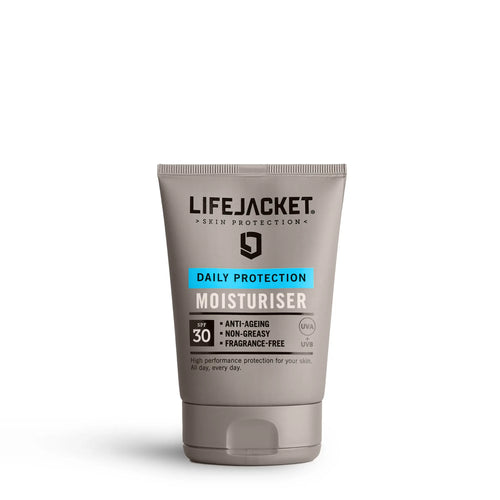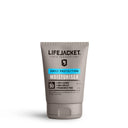A guy I know knocked on my door yesterday. He’s in his mid thirties. He runs his own, small audiovisual business. He’s into cars, music and loves water sports. He’s a good guy. Let’s call him Dave.
I hadn’t seen Dave for a few months and he was sporting a slightly red tan (read: burn).
Bear in mind Dave knows what I’m trying to do and what we care about at LifeJacket. I asked if he had been away and, sheepishly, he said he jumped onto a sun bed yesterday for a bit of colour. COVID lockdown and the rain last week was getting him down.
To my mind, the picture I painted of Dave is one of a very normal guy. I would never describe him as vain or somebody that cares endlessly about image. His admission surprised me slightly: the fact that yesterday, he had gone out of his way to find time to visit a tanning salon.
I had and have absolutely no objection to his motivation. A tan is associated with looking better. Looking healthy. Looking fresh. Given the option, most people would always choose looking better over looking worse.
Obviously. I was more puzzled by the choice he had taken to address his issue.
Leaving Dave for one second…
The bare facts
A UK study found that about 86% of melanomas can be attributed to exposure to ultraviolet (UV) radiation, whether that's natural UV from the sun or artificial UV from sun beds.
We know that tanning, whether outdoors or under the artificial light of a salon, causes cumulative damage to the skin over time.
The science of tanning
UV harms the skin cells’ DNA.
Without going into pages of science, tanning is the body’s response to DNA mutation.
The output of this response happens to be darkening of the skin.
So, nobody tans unless their skin cells are detecting mutations to DNA.
Importantly, these imperfections, or mutations, can lead to skin cancer.
Sun beds
In 2009, the International Agency for Research on Cancer re-classified solariums, or sun beds, as a Group 1 carcinogen, putting them in the same category as tobacco and asbestos.
The high-pressure sunlamps used in tanning salons emit levels of UV radiation up to 5x stronger than the midday Australian summer sun. Such intensity in a largely unregulated industry where training of staff is not mandatory, increases the health risks considerably. The risk is greater in unsupervised commercial sun bed operations and when sun beds are used in the home, where the duration of UV radiation exposure is up to the discretion of the individual.
Not surprisingly, people who use tanning salons are 2.5x times more likely to develop squamous cell carcinoma (a form of skin cancer). According to recent research, exposure to tanning beds when you’re young increases melanoma risk by 75%.
And so, in October 2013, Australia banned commercial sun beds entirely. To my knowledge, no other countries have followed suit unfortunately.
Going back to Dave…
I soon realised that Dave’s visit to the salon for a quick shot of UV is not uncommon.
In the US, 35% of people have used a sun bed at some point. It’s a $1 billion-a-year industry over there and continues to grow.
In Northern Europe, approximately 10% of the population use sun beds on a regular basis for tanning purposes.
A study in Sweden estimated that tanning is so popular, the amount of artificial UV the population absorbs from tanning salons is equivalent to a 10% depletion in the ozone layer (a slightly curious statistic from Sweden I thought).
I discovered that the deeper you delve into this subject, the more you realise that my superficial assessment about Dave just wanting to look slightly better in the winter could be overly simplistic.
The root cause
The motivation for many people when visiting a tanning salon is one, or a combination of
- Wanting to look better
- Tanning makes them feel good
- Relaxation or
- They want a pre-holiday, pre-tan.
However, in extremis, there is a cohort of people who have more deep-rooted impulses to pay a visit to the tanning salon.
In one piece of research in the US, 70% of frequent sun bed users met criteria for UV light substance abuse or dependence disorders.
Some of the people involved in the study reported either missing social events to go and tan, facing social consequences because of tanning, or continuing to tan despite knowing the health risks.
As with other addictive behaviours (like smoking), the younger a person is when the behaviour starts, and the more frequently they tan, the greater the likelihood of dependence. There's also evidence that some frequent tanners are self-medicating underlying psychiatric disorders.
Some researchers believe excessive tanning may be a form of body dysmorphic disorder (BDD). Body dysmorphic disorder is the obsession over a specific body part and the belief that this body part is deformed or defective. In this case, the skin becomes the subject of the disorder.
In winter time, there's also Seasonal Affective Disorder to consider whereby a negative reaction to long, dark winters can often be another driver for frequent sun bed tanning. This might explain the previous statistic from Sweden.
I’m not sure where Dave sits on this spectrum and whether he’s a casual or a dependent user. What I have learnt over the years is that it helps to understand Dave’s motivations first and talk to them if I am to succeed in our quest to reduce skin cancer incidence in men.
People respond in very different ways. In fact, this is something I think about every day in terms of the LifeJacket mission. How to get people to care about something that isn’t high on the list of priorities in the context of day-to-day challenges is a challenge in itself.
Approach 1
It’s very easy for me to wave around a few cancer statistics and wax lyrical about the dangers of UV light.
That might work for some. But a lot of people brush it off as nanny state advice, marketing hearsay or something that won't impact them. Largely, because there are no obvious symptoms to skin cancer, like pain.
Approach 2
Many people (young people especially) put off future pain for present day benefit.
So, they're happy to risk skin cancer later in the life in order to look good today. That's a choice they're making today and it’s entirely their choice.
So, the method of trying to get them to take a longer-term view is different.
It makes more sense to explain what the sun can do to a person’s looks in the short-term, just as Cancer Research UK did in their “See beyond the tan” campaign.

Approach 3
For those with more of a dependence on tanning, the approach needs to be very different.
Based on author Johann Hari’s thesis around addictions, human beings have an innate need to bond and connect.
When we're happy and healthy, we'l bond with people around us. When we can’t because we're traumatised, isolated or beaten down by life, we'll bond with something that gives us some sense of relief. It might be alcohol, nicotine or, in this case, tanning beds.
The pathway out of unhealthy bonds is to try and form healthy bonds. To be connected to people you want to, and enjoy spending time with. I concede it’s easy to say flippantly that this is the solution. To any sufferer in serious inner turmoil, this might seem like an impossibility in itself. All I’m trying to say for the purposes of this blog is that if we're trying to steer a dependent user of sun beds away from visiting the salon every week, scaremongering will not work.
That's why we try so hard to connect with our brothers. To build a tribe. To help and support guys all over the world. We'll try to be there for any of you at any time. Just pick up the phone or drop us a line. Our friends at Melanoma UK have been on a campaign to put a stop to sun beds in the UK for years and they're also available for any of our UK-based friends.
A smack in the chops
All that being said, I can't finish this post without emphasising how bad sun beds are for the skin.
Granted they can be used medically to treat a small handful of conditions but that's under strict supervision and guidance.
The pre-tan argument is nonsense as a tan offers up the equivalent protection of SPF 2-3.
Australia took the lead in banning commercial solariums and other governments need to follow.
My proposal?
Fake tan.
This might be a plaster on a much bigger problem but it's so much safer.
If a 'Dave' isn’t too embarrassed to admit he drove to a tanning salon, he shouldn’t be too embarrassed to use a fake tan product.
There’s a lot of data in this week’s post and I went a bit off piste with the psychology of addiction stuff. But in a nutshell, tanning salons are really, really bad. They materially increase your chances of getting skin cancer. If that doesn't immediately put you off, they'll make your skin look terrible pretty quickly.
Please give some thought to my alternative suggestion. It might just save your life.
Thanks so much for reading.







